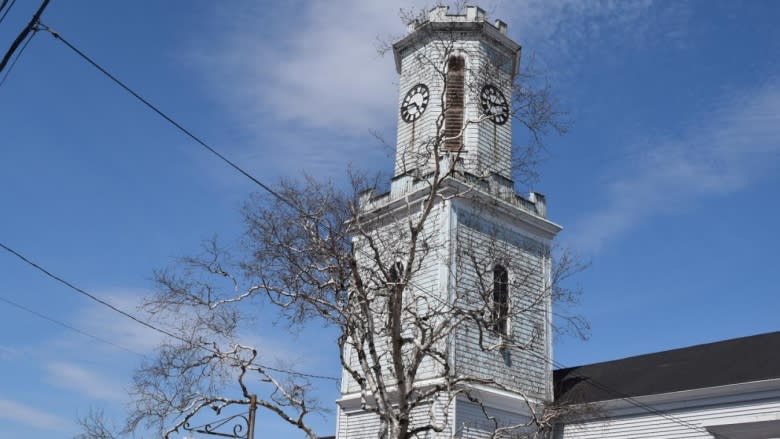'National treasure': Pathfinder window leaves New Brunswick, sold to U.S. church
Now that a one-of-a-kind stained-glass window from the building formerly known as St. George's Anglican Church has been sold to a church in Minnesota, former parishioners are overwhelmed with regrets.
The Pathfinder window has a long history, being the only pane of the iconic Jesus and a Boy Scout image — copied widely across England and the world — authenticated by the original British war painter Ernest Stafford Carlos's family.
Carlos died in 1917.
"Well, we were really blessed because the artist that created that painting only permitted two windows to be made and placed in churches," said Arlene Trask, a former parishioner. "Our church, St. George's, was chosen as one and it was placed in another church on one of the islands of England."
"But during the Second World War, that church had been bombed and their window destroyed," she said in front of the building Monday.
"We felt very blessed to have this piece of our history in our church."
But three weeks ago, the window was sold to a church in Minnesota. Amateur Saint John historian David Goss estimates the window could have been sold for $50,000. The building's owners, who bought the property from the former church, would not reveal the sale price.
Saint John Scout legend honoured
The church building is the oldest in Saint John, built in 1821, and the window was unveiled in 1941.
The window, made by the oldest stained-glass window company in the western hemisphere, honoured Stanley Olive, the longest-surviving Scout leader in the British Commonwealth at the time, who lived on the lower west side of Saint John.
The community reached out to the family of Carlos to have the window made and for them to authenticate it.
Goss, another former parishioner and an amateur historian, said a note from Toronto-based window-company McCausland indicated they copied the original painting as closely as possible in order to keep it as accurate as possible.
"Now there are many copies," Goss said. "This painting hung in every Boy Scout hall from one side of the world to the other."
"It wasn't unusual to see the painting, but it was unusual to see it transfer to a window."
Building back on the market
Like the window, the former church building has a complicated history.
Members originally triedremoving its heritage designation in 2013, allowing for easier repairs in order to save the building itself or allow fixtures to be salvaged, but the church was sold two years ago.
The new owners were successful in havingthe designation removed and the church was converted into a restaurant.
However, the building is now back on the market with the restaurant closed.
Trask said it was incredibly frustrating to try to remove the designation only to have it happen once it's too late to save what's important.
A spokesperson for the the Anglican Diocese of Fredericton, the original property owner, said when the organization sold the building it still had the designation, complicating what can be done to salvage items from it.
While the price of the window is difficult to establish, Goss estimates, in the right market, The Pathfinder could have sold for $50,000, or more.
A real market for Boy Scout paraphernalia exists, the historian said.
"Way more than you'd think," he said.
Goss said he's happy to see the old fixtures move to a new church, creating a sort of Phoenix allegory about rebirth.
Despite his protests to other members of the community that The Pathfinder was significant and should be promoted better, his pleas fell on deaf ears. He also feels museums and archives of the province failed.
"If I had of known back in January, I might have been able to pull some strings together," he said. "We've lost so much in Saint John.
"This was a national treasure right here in New Brunswick. It should have stayed in New Brunswick."
Owner responds
According to Carla McCashion, one of the building's new owners, before selling the window she brought in an expert from Nova Scotia.
Despite all the hype, she investigated the rarity of the window and thought it would be more impressive.
"To me, it was almost like a myth," she said.
She wouldn't say how much the window and all the other fixtures sold for, only that it helped pay for outstanding bills on the property.
"Thirteen windows, all the pews, the altar – a majority of the inside of the church," she said about what was sold.
She also said she approached a few parishioners she believed might be interested but said an offer never came.
"They knew." While the window is gone now, the parishioners could have taken the window out of the church before selling it, "no problem."
She said the window was inside the building and not protected by the designation.
And while sympathetic to the church-goers loss, she said, as a businesswoman who has dealt with this ongoing drama for months, her sympathy only goes so far.
"When is this ever going to end?" she said. "If they worried about the church — I don't care if you put this in — they should have dug deeper into their pockets.
"They sold the church two years ago."
For Trask, while not the best-known piece of art in the city, to her The Pathfinder was a lost gem that should never have crossed the border.
"It's just going to be a decoration," she said. "It's not going to have the spiritual meaning and the attachment that it had here.".
"Everything happened so quickly. And really, we just sort of were out on the street, more or less, before we realized what was going on."



